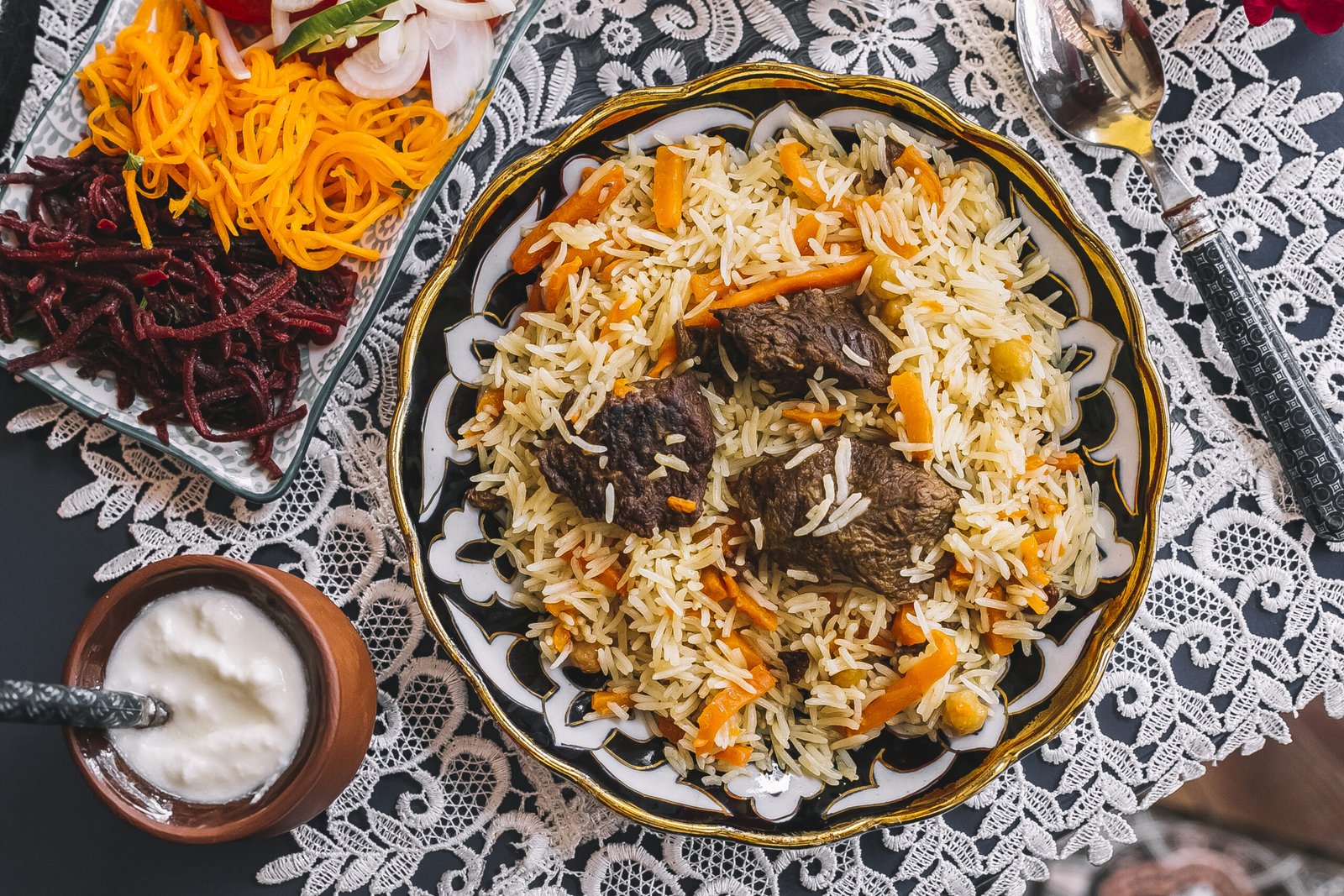1. Origin and History of Hyderabadi Biryani:
Hyderabadi Biryani, a culinary masterpiece, traces its roots to the Nizams of Hyderabad, India. Believed to have originated in the kitchens of the Nizam, the biryani reflects the opulence and rich culinary traditions of the region. Legend has it that the dish was created to address the famine during the Nizam’s reign, combining fragrant Basmati rice, aromatic spices, and succulent meat to form a dish that transcends culinary boundaries.
Influenced by Mughlai and Persian cooking styles, Hyderabadi Biryani evolved over centuries, becoming a symbol of Hyderabad’s cultural identity. The unique preparation involves layering partially cooked rice and marinated meat, allowing them to meld flavors during the slow-cooking process, resulting in a harmonious blend of spices and textures. Today, Hyderabadi Biryani stands as a testament to the city’s rich heritage and continues to captivate taste buds worldwide.
2. Ingredients that Make a Perfect Hyderabadi Biryani:
A perfect Hyderabadi Biryani is a symphony of carefully chosen ingredients that harmonize to create a delightful culinary experience. At its core is the fragrant Basmati rice, known for its long grains and aromatic profile. The meat, traditionally goat or chicken, is marinated in a blend of yogurt, spices, and herbs, infusing it with rich flavors. The hallmark of Hyderabadi Biryani lies in its unique spice mix, featuring aromatic spices like cardamom, cloves, and cinnamon, alongside the warmth of saffron.
Fried onions add a crispy texture and a sweet undertone, while the process of layering partially cooked rice and marinated meat allows the ingredients to intermingle, creating a tapestry of tastes. Ghee, a generous touch of mint, and coriander contribute the final touches, elevating the dish to a culinary masterpiece that embodies the rich heritage of Hyderabad.
3. Popular Hyderabadi Biryani Varieties:
Hyderabadi Biryani, with its versatile and flavorful nature, has given rise to several popular varieties that cater to diverse tastes. The Dum Biryani, characterized by slow-cooking marinated meat and partially cooked rice in a sealed pot, stands as the epitome of traditional Hyderabadi preparation.
The Kacchi Biryani takes a distinct approach, using raw marinated meat that’s layered with raw rice before cooking, imparting a unique depth of flavors. For those seeking a vegetarian option, the Hyderabadi Vegetable Biryani showcases an array of vegetables intertwined with aromatic spices and fragrant rice. Each of these varieties reflects the city’s culinary prowess, offering a delightful journey through the diverse and delectable world of Hyderabadi Biryani.
4. Traditional Cooking Techniques:
The preparation of Hyderabadi Biryani is a testament to the traditional cooking techniques that have been passed down through generations, preserving the authenticity of this iconic dish. One of the key methods is Dum Pukht, where marinated meat and partially cooked rice are layered in a sealed pot and slow-cooked over a low flame, allowing the flavors to meld and infuse into every grain of rice.
This meticulous process ensures that the meat is tender and succulent while the rice attains a fragrant perfection. The art of marination, using a blend of yogurt and an array of aromatic spices, is another crucial technique that imparts depth and complexity to the dish. The careful balance of heat and time in these traditional cooking methods elevates Hyderabadi Biryani to a culinary masterpiece, capturing the essence of Hyderabad’s rich culinary heritage.
5. Hyderabadi Biryani and Cultural Significance:
Hyderabadi Biryani extends beyond being a culinary delight; it holds profound cultural significance, deeply embedded in the tapestry of Hyderabad’s heritage. The dish has become a symbol of communal harmony, as its evolution reflects the amalgamation of Mughlai, Persian, and local culinary influences. Traditionally associated with grand celebrations and festive occasions, the serving of Hyderabadi Biryani is a gesture of hospitality and warmth.
Its preparation often involves a collaborative effort, bringing people together to partake in the intricate process of creating this flavorful masterpiece. The aromatic aroma of the biryani wafting through the air during special gatherings encapsulates the spirit of togetherness and shared joy. In this way, Hyderabadi Biryani transcends its status as a culinary creation and becomes a cultural emblem, embodying the traditions, diversity, and communal spirit of the vibrant city of Hyderabad.

6. Best Places to Enjoy Hyderabadi Biryani:
Savoring the authentic taste of Hyderabadi Biryani is an experience best enjoyed at the city’s renowned culinary establishments, where this iconic dish is crafted with finesse. One such destination is Paradise, a legendary eatery that has perfected the art of Hyderabadi Biryani over decades. Its flavorful biryani, served in a vibrant and bustling ambience, is a must-try for enthusiasts. Another gem is Shadab, known for its rich and aromatic biryanis, capturing the essence of traditional Hyderabadi flavors.
For those seeking a regal dining experience, Bawarchi stands out, offering a royal feast with its delectable biryanis. The historic charm of Nimrah Café and Bakery near Charminar also attracts biryani aficionados, providing a unique backdrop to relish this culinary masterpiece. Exploring these iconic establishments ensures not only a gastronomic journey through Hyderabadi Biryani but also a cultural immersion into the heart of the city’s vibrant culinary scene.
7. Comparisons with Other Biryani Styles:
While biryani holds a special place in the hearts of food enthusiasts across the globe, Hyderabadi Biryani stands out for its distinctive preparation and flavor profile, setting it apart from other biryani styles. In comparison to the robust and aromatic Lucknawi biryani, Hyderabadi Biryani tends to be spicier, with a unique blend of spices that imparts a depth of flavor. Contrasting with the Kolkata Biryani, which features potatoes and a lighter touch of spices, Hyderabadi Biryani is known for its indulgent use of aromatic basmati rice and succulent meat.
The South Indian counterpart, the Thalassery Biryani, often incorporates regional spices and shorter-grain rice, offering a different sensory experience. Each biryani style carries its own charm, but Hyderabadi Biryani’s distinctive blend of Mughlai and local influences ensures its place as a culinary masterpiece, renowned for its rich flavors and cultural significance.
8. Home-Cooked Hyderabadi Biryani Recipes:
Ingredients:
2 cups basmati rice
500g chicken or lamb, cut into pieces
1 cup yogurt
2 large onions, thinly sliced
1/4 cup cooking oil
1/4 cup ghee (clarified butter)
2 tablespoons ginger-garlic paste
1/2 cup chopped mint leaves
1/2 cup chopped coriander leaves
4-5 green chilies, finely chopped
1 teaspoon turmeric powder
1 teaspoon red chili powder
1 teaspoon garam masala
1 teaspoon cumin seeds
4-5 whole cloves
4-5 whole green cardamom
2-3 black cardamom pods
2-inch cinnamon stick
A pinch of saffron strands soaked in 2 tablespoons warm milk
Salt to taste
Instructions:
Rinse the basmati rice in cold water until the water runs clear. Soak the rice in water for about 30 minutes.
In a large pot, bring water to a boil. Add soaked and drained rice along with some salt. Cook until the rice is 70-80% cooked. Drain the water and set the rice aside.
In a separate bowl, mix yogurt, ginger-garlic paste, turmeric powder, red chili powder, and salt to create a marinade. Add chicken or lamb pieces and let it marinate for at least 30 minutes.
In a deep, heavy-bottomed pan, heat oil and ghee. Add cumin seeds, cloves, green cardamom, black cardamom, and cinnamon. Sauté until aromatic.
Add thinly sliced onions and fry until golden brown. Remove half of the fried onions for later use.
Add marinated meat to the pan and cook until it’s partially done. Add chopped mint, coriander leaves, green chilies, and garam masala. Cook for another 5-7 minutes.
In the same pan, layer the partially cooked rice over the meat. Sprinkle the saffron-infused milk and the reserved fried onions on top.
Cover the pan with a tight-fitting lid or seal it with dough to create a Dum effect. Cook on low heat for about 20-25 minutes or until the meat is tender and the rice is fully cooked.
Gently fluff the rice with a fork, mixing the layers. Serve the Hyderabadi Biryani hot, garnished with additional fried onions, fresh mint, and coriander leaves.
9. Biryani Accompaniments and Side Dishes:
Complementing the rich and aromatic flavors of Hyderabadi Biryani, a carefully curated selection of accompaniments and side dishes enhances the overall dining experience. Raita, a cooling yogurt-based condiment, often infused with chopped cucumbers, tomatoes, and mint, provides a refreshing contrast to the spiciness of the biryani. Mirchi ka Salan, a tangy and spicy chili curry, adds a unique kick to the meal, while Bagara Baingan, a flavorful eggplant curry, contributes a savory depth.
A side serving of boiled eggs, often marinated in the biryani’s masala, adds protein richness. Additionally, a simple salad of sliced cucumbers, onions, and tomatoes with a dash of lemon serves as a crisp and light accompaniment. These carefully paired side dishes not only balance the intensity of the biryani’s flavors but also showcase the diversity of Hyderabad’s culinary offerings.
Frequently Asked Questions (FAQs)
Q: What is Hyderabadi Biryani?
A: Hyderabadi Biryani is a flavorful and aromatic rice dish, originating from the city of Hyderabad in India. It’s a traditional blend of basmati rice, tender meat (usually chicken or mutton), and a rich mix of spices, herbs, and saffron.
Q: What sets Hyderabadi Biryani apart from other biryanis?
A: Hyderabadi Biryani is known for its unique cooking method called “Dum Pukht,” where meat and rice are cooked together in a sealed pot. This slow-cooking technique allows the flavors to infuse, creating a distinct taste and aroma.
Q: Is Hyderabadi Biryani always spicy?
A: While it can be spicy, the level of spice can be adjusted to suit individual preferences. Hyderabadi Biryani is versatile, offering variations ranging from mild to extra spicy, accommodating diverse taste preferences.
Q: What types of meat are commonly used in Hyderabadi Biryani?
A: Chicken and mutton are the most common choices for meat in Hyderabadi Biryani. Each adds its unique flavor, and the choice often depends on personal preference.
Q: Are there vegetarian versions of Hyderabadi Biryani?
A: Yes, there are vegetarian versions that replace meat with ingredients like vegetables, paneer (Indian cottage cheese), or soya chunks. The spices and cooking method remain similar, providing a delightful vegetarian alternative.
Q: What is the significance of saffron in Hyderabadi Biryani?
A: Saffron is used to add a distinct flavor, fragrance, and a golden hue to the biryani. It enhances the overall visual appeal and contributes to the luxurious taste of the dish.
Q: Can Hyderabadi Biryani be prepared in advance?
A: Yes, it can. In fact, many believe that the flavors of Hyderabadi Biryani intensify when it’s allowed to rest for some time after cooking. This makes it a convenient choice for hosting gatherings or events.
Q: What accompaniments go well with Hyderabadi Biryani?
A: Hyderabadi Biryani is often served with raita (yogurt with spices), mirchi ka salan (a chili-based curry), and a refreshing salad. These sides complement the biryani and enhance the overall dining experience.
Q: Can I reheat Hyderabadi Biryani?
A: Yes, you can reheat Hyderabadi Biryani. To retain its moisture and flavor, it’s advisable to use a method that doesn’t dry out the rice, such as steaming or microwaving with a damp cloth covering.
Q: Is Hyderabadi Biryani gluten-free?
A: Yes, Hyderabadi Biryani can be gluten-free if prepared with gluten-free ingredients. The primary components, rice and meat, are naturally gluten-free. However, it’s essential to check and ensure that other ingredients and spices used are also gluten-free.
Conclusion
Whether enjoyed at legendary establishments or crafted with love in home kitchens, Hyderabadi Biryani stands as a symbol of communal joy, celebration, and the vibrant spirit of a city that takes pride in its culinary prowess. This dish not only satisfies the palate but also offers a savory journey through Hyderabad’s rich cultural and gastronomic heritage.




